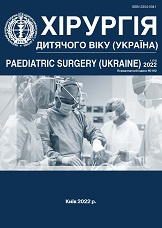Analysis of the effectiveness of the halo-gravitational traction system as a factor influencing blood loss in the surgical correction of complex scoliotic deformities in children
DOI:
https://doi.org/10.15574/PS.2022.74.34Keywords:
intraoperative bleeding, spinal deformity, halo-gravity tractionAbstract
Halo-gravity traction (HGT) systems are widely used in leading clinics around the world as a staged method for correcting complex (>100°) scoliotic deformities of the spine in children. Today there is no single approach to the use of this technique, and each doctor makes a decision regarding the treatment regimen empirically, based on his clinical experience.
Purpose - to identify the factors that affect the amount of blood loss during surgical correction of scoliotic deformity in children.
Materials and methods. 76 patients aged 7 to 17 years were examined, on average 11.0±2.8 years. I (experimental) group - 38 children were treated with HGT using the developed tactics of staged surgical treatment; II (control) group - 38 children who underwent one-step surgical correction. The age of children in the groups in group I was 11.0±2.8 years, in group II - 11.2±2.8 years, the age of children in groups was statistically the same (t=-0.409; p=0.684). There were 28 (36.8%) boys and 48 (63.2%) girls. The distribution of children by age and sex in the groups was the same. Data on operative blood loss were statistically processed.
Results. According to the statistical study, it can be argued that the blood loss during surgical correction of scoliotic deformity is most affected by the angle of deformation and age of the patient. At an angle of deformation of >100° blood loss is significantly greater than at an angle of <100°, children over 14 years also observed a significant increase in blood loss, and this is associated not only with greater body weight but also with the fact that these children the greater the angle of deformation of the spine, as well as the use of HGT, the angle of deformation decreases less than in younger children.
Conclusions. It was determined that after HGT in children the angle of deformation decreased statistically significantly (p<0.001) by an average of 36.5±14.9°. The change in deformation in boys and girls was the same. With surgical correction of scoliotic deformity <100° blood loss (1025.0±235.9 ml), (statistically significant) (p<0.001) is statistically significantly less than blood loss with correction of deformity greater than 100° (1297.5±327.8 ml). With age, blood loss increases in children, and this difference between age subgroups is statistically significant (α=0.05). The value of the angle of scoliotic deformity after surgical correction has a statistically significant (r=0.576; p=0.001) effect on blood loss, the value of surgical correction of deformity on blood loss (r=0.015; p=0.879) does not affect.
The research was carried out in accordance with the principles of the Helsinki declaration. The study protocol was approved by the Local ethics committee of all participating institutions. The informed consent of the patient was obtained for conducting the studies.
No conflict of interest was declared by the authors.
References
Everitt BS, Skrondal A. (2010). The Cambridge Dictionary of Statistics. Ed. 4. Cambridge University Press: 480. https://doi.org/10.1017/CBO9780511779633
Little JP, Izatt MT, Labrom RD, Askin GN, Adam CJ. (2013, May 16). An FE investigation simulating intra-operative corrective forces applied to correct scoliosis deformity. Scoliosis. 8 (1): 9. https://doi.org/10.1186/1748-7161-8-9; PMid:23680391 PMCid:PMC3680303
Mezentsev AO, Petrenko DIe. (2018). Retrospektyvnyi analiz uskladnen pislia khirurhichnoho likuvannia urodzhenoho kifozu u ditei. Ortopedyia, travmatolohyia y protezyrovanye. 3: 39-44. https://doi.org/10.15674/0030-59872018339-44
Rohozynskyi V, Levytskyi A, Dolianytskyi M, Benzar I. (2020). Treatment of Severe Spinal Deformations in Children with Idiopatic Scoliosis Using Halo-Gravity Traction. Wiadomości Lekarskie. 73 (10): 2144-2149. https://doi.org/10.36740/WLek202010107; PMid:33310937
Salmingo R, Tadano S, Fujisaki K et al. (2012). Corrective force analysis for scoliosis from implant rod deformation. Clin Biomech (Bristol, Avon). 27: 545-550. https://doi.org/10.1016/j.clinbiomech.2012.01.004; PMid:22321374
Semmelink K, Hekman EEG, van Griethuysen M, Bosma J, Swaan A, Kruyt MC. (2021, Jan). Halo pin positioning in the temporal bone; parameters for safe halo gravity traction. Spine Deform. 9 (1): 255-261. https://doi.org/10.1007/s43390-020-00194-2; PMid:32915397
Vidal-Lesso A, Ledesma-Orozco E, Daza-Benítez L, Lesso-Arroyo R. (2014). Mechanical Characterization of Femoral Cartilage Under Unicompartimental Osteoarthritis. Ingeniería mecánica tecnología y desarrollo. 4 (6): 239-246.
Voor MJ, Anderson RC, Hart RT. (1997, Sep). Stress analysis of halo pin insertion by non-linear finite element modeling. J Biomech. 30 (9): 903-909. https://doi.org/10.1016/S0021-9290(97)82887-4
Wang Y, Li C, Liu L, Li H, Yi X. (2021). Presurgical Short-Term Halo-Pelvic Traction for Severe Rigid Scoliosis (Cobb Angle >120): A 2-Year Follow-up Review of 62 Patients. Spine (Phila Pa 1976). 46 (2): E95-E104. https://doi.org/10.1097/BRS.0000000000003740; PMid:33038196
Downloads
Published
Issue
Section
License
Copyright (c) 2022 Paediatric Surgery (Ukraine)

This work is licensed under a Creative Commons Attribution-NonCommercial 4.0 International License.
The policy of the Journal “PAEDIATRIC SURGERY. UKRAINE” is compatible with the vast majority of funders' of open access and self-archiving policies. The journal provides immediate open access route being convinced that everyone – not only scientists - can benefit from research results, and publishes articles exclusively under open access distribution, with a Creative Commons Attribution-Noncommercial 4.0 international license(СС BY-NC).
Authors transfer the copyright to the Journal “PAEDIATRIC SURGERY.UKRAINE” when the manuscript is accepted for publication. Authors declare that this manuscript has not been published nor is under simultaneous consideration for publication elsewhere. After publication, the articles become freely available on-line to the public.
Readers have the right to use, distribute, and reproduce articles in any medium, provided the articles and the journal are properly cited.
The use of published materials for commercial purposes is strongly prohibited.

